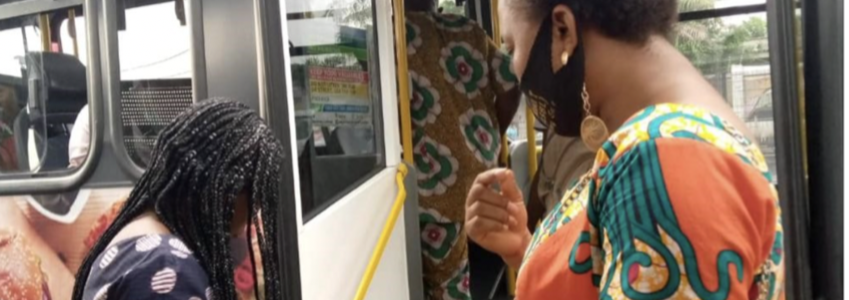Author: Professor Laurie Pickup, International Director, Vectos (SLR)
Mobility is a fundamental freedom and human right. It is a sad fact in 2024 that, when it comes to travel, SHE-CAN is often SHE-CAN’T. While this blog focuses on sub-Saharan Africa, the reality it describes is a global one.
My journey in the transport profession started 50 years ago with my PhD research into women’s mobility issues in their job choice. At the time it was the first work in a field that has exploded in recent years. A professional colleague from the old East Germany remarked to me many years later: “At university we were all told to read your work; it was the only research that existed at the time”. I received the same comment from academics in the USA. For many of those early years, the idea of working on women’s mobility was seen as simply ‘odd’.
The focus of research into women’s mobility in the early years was on the impact of quite rigid gender roles on women’s access to jobs and education, given their far lower level of access to cars and motorised two-wheelers than men. The car was the mobility benchmark. However, it was clear that something more fundamental was shaping the travel patterns of women and girls:the simple fear of travelling and going out, the fear of being sexually harassed and assaulted. In many societies, sexual harassment against women and girls when travelling was ‘the way that it was’. Thankfully we now live in better times — or do we?
Numerous surveys undertaken across the globe over the last 10 years (Including my own work in Egypt) underline that between 60 and 90 % of women and girls have been subject to sexual harassment or assault when they travel. In 2023, there were 733 million women in Africa, with a median age under 25 years. So, we can say with confidence that between 440 and 660 million (primarily younger) women are travelling today in Africa with direct experience of sexual harassment or the trauma of sexual assault. In addition, beyond the personal impacts that this has on women’s life quality, there are enormous economic and social consequences for Africa. The International Labour Office of the UN estimated this impact in 2016 to be equivalent to 15% of GDP.
My conclusion to these stark statistics is clear: that sexual harassment and sexual violence against women is one of the biggest transport problems in the world, an acute problem to which the transport profession has been blind. Why is this? The voices of women speaking out in 2024 are far greater than when I began my professional career half a century ago. In response to events in the USA, the MeToo movement has underlined that ‘enough is enough’. However, the problem of sexual harassment and sexual violence that women suffer when they go out, or when they take up jobs in the transport sector, is as big a problem today as it ever was.
More and more we see decision-making frameworks inadequate and resistant to change. Sexual harassment and sexual assault in the travelling environment are important issues that fall between many stools, stakeholders pointing fingers at each other as to who bears the primary responsibility for addressing the issue.
Over the last 15 years, I have attended many international workshops and conferences on transport safety. On raising the harassment issue as an area for legitimate concern, my intervention is seen as being out-of-scope — although I can see many (men) nodding in sympathy.
Collaboration is key.
As in other global regions, in Africa there is the need to educate a new mind-set to instil a gender lens into professional practice. There is a need to (i) Put the problem faced by millions of African women and girls at the centre, (ii) Assign responsibility, (iii) Have one overarching organisation to manage the whole process, and (iv) Engage the relevant stakeholders who are at the core and edge of the issue, and finally (v) Set-up a collaborative mechanism to find consensus and co-create what needs to be done — do it, and monitor whether it is working.
In the African context, support from the national and regional levels of government will be a critical step in setting up this process and giving the issue the weight it deserves. In addition, there will be the need to fully engage both the formal and informal transport systems, as part of a new, more inclusive approach to planning.
The High-Volume-Transport (HVT) Programme, funded by UK AID, is a current initiative trying to make a step-change to women’s mobility freedoms in sub-Saharan Africa. The EMPOWER project, running since 2021, has been working with stakeholders in Nigeria, Malawi, and Rwanda to both underline how acute the problem of sexual harassment is, and to design a tool that can provide stakeholders with the necessary intelligence and policy options they need.
The SHE-CAN tool has been the result.
SHE-CAN is an acronym for ‘Sexual Harassment Engagement, Changing Attitudes, meeting Needs’. A major strength of the tool is its ability to act as a focus for the multi-stakeholder engagement process I have outlined above. This year, the SHE-CAN tool is being applied in 10 countries in sub-Saharan Africa. It is hoped, with the necessary government-level support and key local champions, that SHE-CAN will be a focus around which stakeholders can act and eradicate the plague of sexual harassment and assault that African women and girls face when they travel daily.
Gender is now centre-stage, and the challenge is to set up frameworks and processes to deliver what we know is required. Collaborative working is essential. Some fifty years on, nobody now accuses my work of being ‘odd’ — that simple fact is a career achievement.

